EXCLUSIVE LOOK! INSIDE RYAN DUNGEY’S 2013 KTM 450SXF WORKS MOTOCROSS BIKE (AND WE MEAN INSIDE)
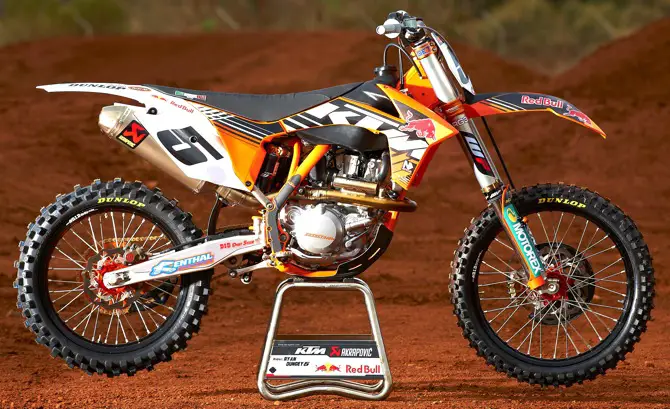
Dungey’s KTM 450SXF: KTM has yet to decide whether to call the production version a 2012-1/2 or a 2013 model. It is scheduled for very early production. As a works bike KTM has tested four-speed gearboxes as well as five-speeds (the 450EXC loaner engine comes with a six-speed gearbox), but Dungey’s bike and the production bike will come with five-speeds. The KTM Grand Prix riders might use four-speeds. KTM will meet the AMA homologation rules (as soon as someone at the AMA figures out what they are). Many of the trick parts on Dungey’s bike are available through the KTM Hard Parts catalog…and the Kite wheels can be purchased at Dubya USA.
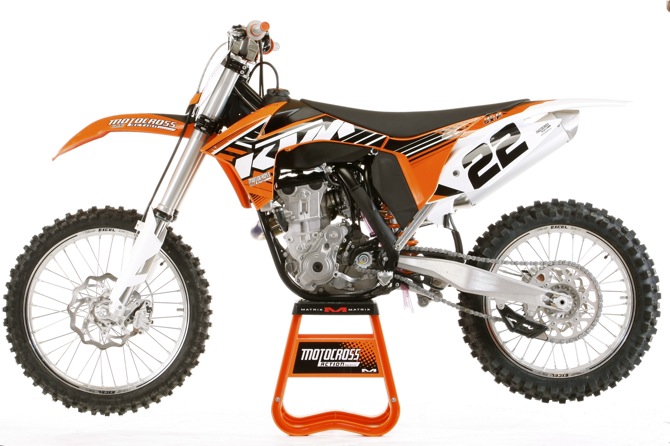
Stock 2012 KTM 450SXF: This is MXA’s stock 2012 450SXF. Compare it to Dungey’s bike above. Note the size of the sand-cast engine, position of the electric starter and the shape of the lower frame cradle. Dungey’s fuel-injected engine is smaller, which allows the frame cradle to wrap tighter to the engine cases. The frame cradle is unique to the works bike and does not share its shape with either the 450SXF or the 450EXC.

Dungey’s Engine: Dungey’s bike uses Del West valves, the stock bore-and-stroke and stock head (although ported). The cam timing has been changed (with the help of cams from the KTM factory). The team can choose between a stock ignition that has been reprogrammed or a GET ignition. The bore is slightly smaller (95mm compared to 97mm) and the stroke is longer 63mm versus 60.8). The exhaust system is from Akrapovic and has a bung on the head pipe for an oxygen sensor.
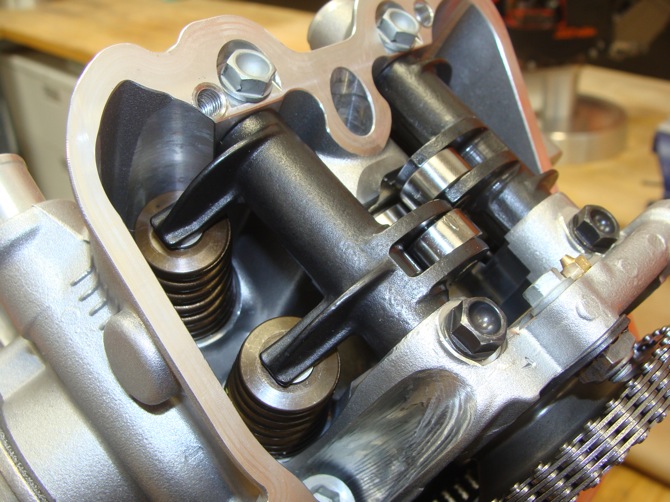
Dungey’s rocker arm valve train: If you were expecting a double overhead cam engine, shim under bucket engine or finger follower engine, you will be surprised to learn that Dungey’s 450SXF uses a single cam that feeds a set of tandem roller rocker arms. The cam is in the center of the head and the rollers ride on the cam lobes to activate the exhaust rocker arms (left) and intake arms (right). This is a very light design.

Stock finger follower valve train: All of the previous KTM four-stroke motocross engines (250, 350 and 450SXF) use finger followers to activate the valves via double overhead cams. Finger followers are very high-tech, but you can see in this 350SXF head that the system is more complex than the works bikes’ single overhead cam and rocker arms.
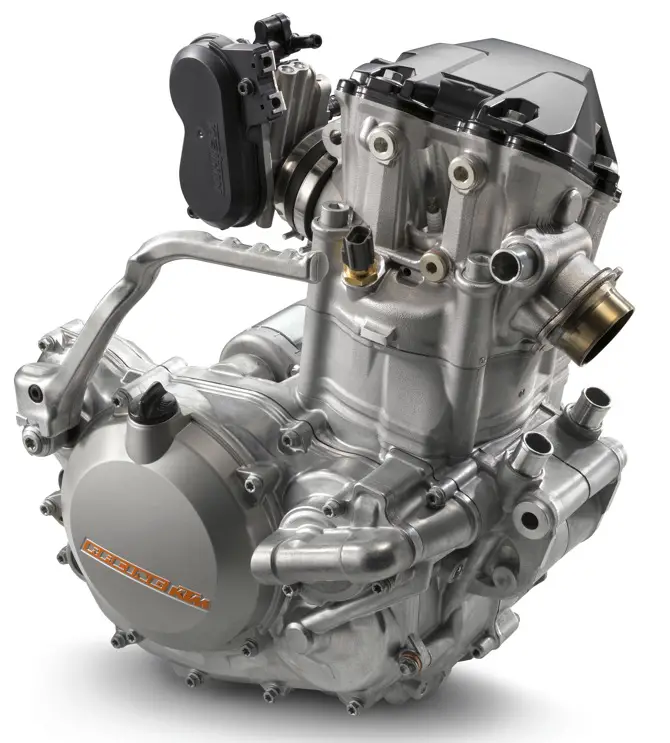
The base 2012 KTM 450EXC engine: This is the EFI engine that Dungey’s race bike started with and that the production version will be based on. It comes standard in the 2012 KTM 450EXC (although Dungey’s engine has had the kickstarter removed and the port covered with an aluminum plug). Compared to the previous 450SXF engine, this version has die-cast instead of sand-cast cases, reconfigured balancer and water pump and a completely different layout. It weighs six pounds less than the SXF engine.

Dungey’s electric starter: Compared to the electric starter on the 2012 KTM 450SXF, the 2013 model will have a more compact electric starter system (with the drive system on the clutch side of the engine instead of the ignition side). The hash marks on the casting that holds the electric motor can actually be used to change the rpm of the starting point of the engine (by rotating the motor to align the marks). We don’t know why that would be necessary. The stock Yuasa battery has been replaced by an almost three pound lighter Full Spectrum Genesis battery that produces 125 cold-cranking amps (CCA).

The stock 2012 KTM 450SXF electric starter: The current KTM 450SXF production engine has a much larger electric starter system (above) and it is gear driven from the ignition side of the engine via a cast engine case. Plus, no hash marks.


Dungey’s water routing: As the water is pumped through the fuel-injected 450SXF engine, it spends some time in a reservoir directly above the oil filter cavity. This helps cool the oil more efficiently before pumping the water back up to the radiators and the oil to the top-end.

The stock 2012 KTM 450EXC frame and engine: For comparison purposes, this is what the 2012 450EXC engine looks like in the enduro frame. Dungey’s works engine uses all the basic elements?minus the kickstarter. The 2012 450EXC has a no-link PDS shock system and larger gas tank.
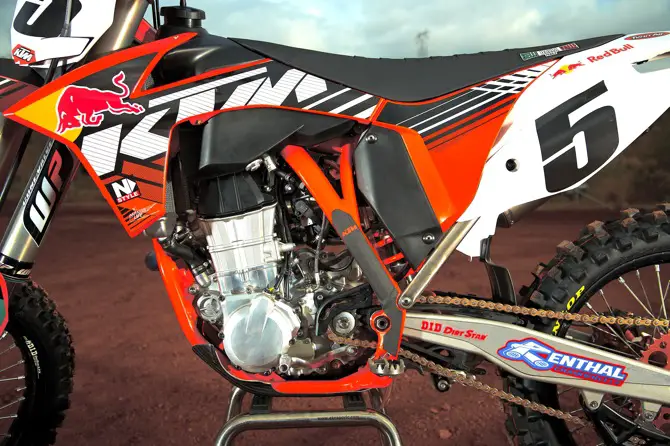
Dungey’s engine internals: Dungey’s KTM uses a Pankl rod and piston. Pankl is an Austrian aerospace and F1 engineering company that makes high-end steel, titanium and aluminum alloy parts. They make pistons and rods for CP and Carillo for aftermarket use and special forged aluminum parts for factory teams. Note the bolt-on airbox cover (the two bolts are added to make sure that the cover doesn’t hook on something and tear off in a race). Dungey runs grip tape on the sides of the frame. The seat cover is a Selle Dalle Valle gripper.

Dungey’s clutch choices: Take note of the Hinson clutch cover, which was installed during testing. This engine uses the Belleville washer diaphragm clutch that comes stock on the 2012 KTM 450SXF (and in the 2012 450EXC engine). It is possible to use a coil spring clutch (with the existing steel basket) if KTM wanted to, but no one is really sure what clutch Dungey will select by time the season starts. On Andrew Short’s 350SXF KTM replaced the stock steel basket with an aluminum one…so KTM has several clutch choices.
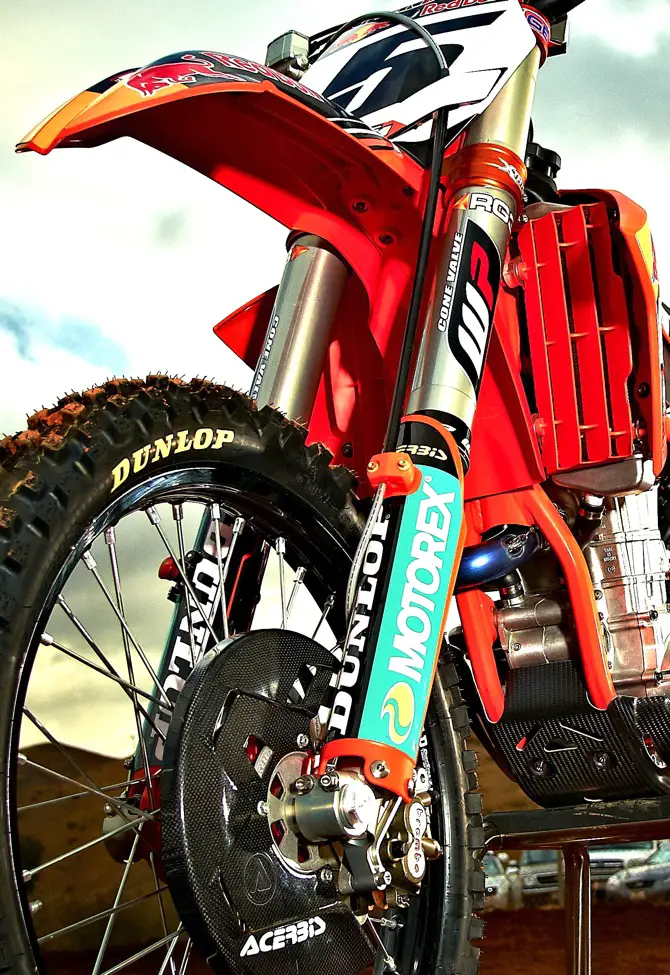
Dungey’s WP Cone Valve forks: The WP forks are 52mm works units…that are most unique in that all the parts are aluminum, save for the fork springs. The subframe has also been cut down. Ryan Dungey started with the suspension settings from Andrew Short’s 350SXF Supercross bike, but has advanced from there to develop his own setup. The works forks feature something called “Cone Valve” damping and are taken care of by RG3.
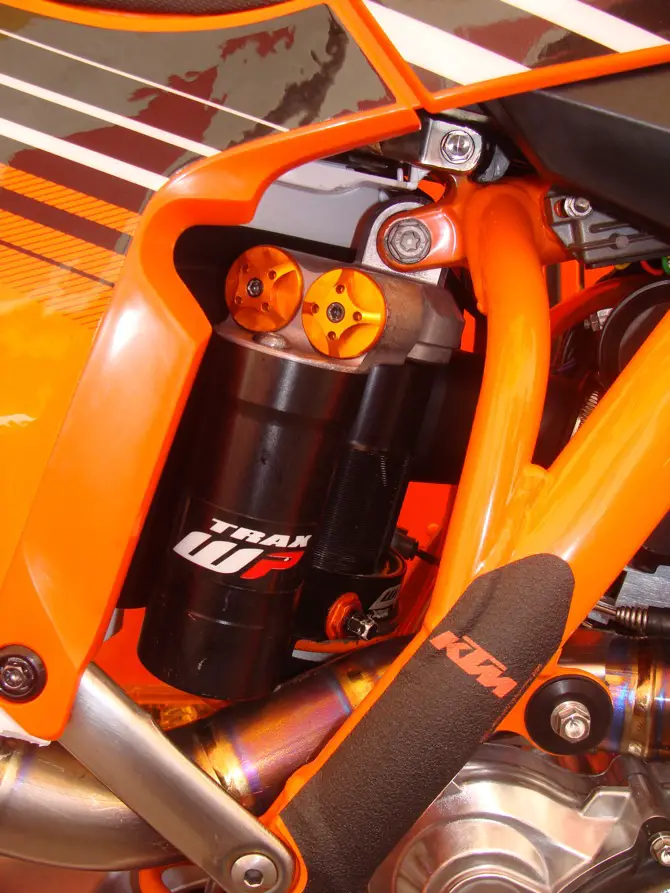
Dungey’s SXS Trax shock: The shock linkage is stock, but the bike is fitted with a WP Trax shock (and the shock is shorter than the stock shock…and much shorter than the Euro-spec shocks). Spring preload is adjusted via an Xtrig worm-drive adjuster
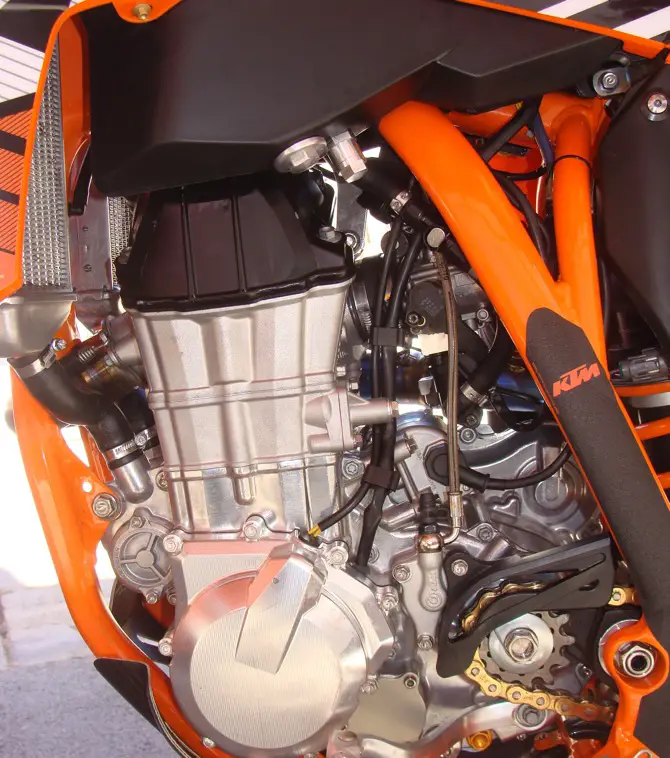
Dungey’s TPS & Cam chain tensioner: The left side of the engine is very clean and uncluttered. The throttle position sensor (TPS) unit on the throttle body is much smaller than last year and also better protected from roost and water. The cam chain tensioner (on the back of the head) is now spring-loaded instead of hydraulic. We would expect a more refined gas tank by the time the 2013 450SXF comes out as a production bike. Prototypes of this engine were raced in Europe this summer in the MX3 series and the Austrian National Championships.

Dungey’s exhaust port: Open up and say ahhh. This is a close-up look inside the exhaust port of the 450 EFI engine.

Dungey’s Kite rear wheel: The tires are Dunlop works tires (without a designation number). The front is a 90/90-21, while the rear is a 120/80-19. The rear caliper is a special works Brembo unit (held in place by a Kite carrier), while the rotor is from Galfer. The chain adjuster bolt is Ti and the rear axle block is special. The rims are black-anodized D.I.D Dirt Stars.
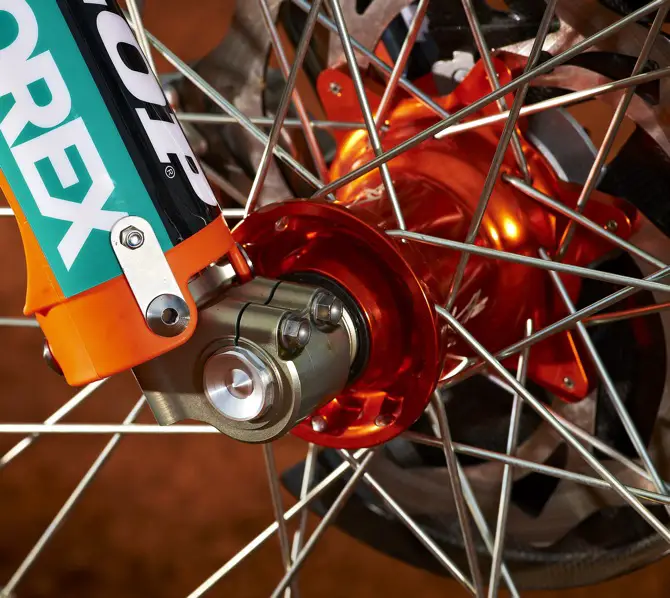
Dungey’s Kite front wheel: The hub is a Kite unit (www.dubyausa.com), which was used by Andrew Short on his 350SXF and by the KTM GP team. The metal strip on the plastic fork guard is a reinforcing strip to keep the fork guard intact should the holeshot device stick. KTM’s holeshot device is made by Kite (and the stock 2012 KTM 450SXF comes with a holeshot device?no other KTMs come with this part stock).

Dungey’s front brake master cylinder: The front brake on Dungey’s prototype 450SXF uses a standard-issue Brembo master cylinder, but Ryan gets to choose between three different front brake calipers (stock, intermediate and maximum power). Ryan chooses the max power caliper.

Dungey’s X-Trig triple clamps: The triple clamps are by X-Trig (www.technicaltouchusa.com) and come with solid high-rise bar mounts. The triple clamps offset is 22mm (which is the same as stock). The triple clamp bolts are titanium.

Dungey’s thread-on gas cap: Note the thread-on gas cap (which is different than all previous KTM works gas caps?most KTM works bikes use thread-on gas caps, but normally the older-model small cap). Dungey’s bike has a larger spout and cap. It turns out that the excessive height of the spout was a mistake and before long Dungey will get a new gas tank with a much sleeker and lower fitting thread-on gas cap.

Dungey’s footpegs: Dungey’s footpeg is big, wide, titanium and mean looking. They are Raptor Extreme pegs (www.raptortitanium.com).
Photos by Frank Hoppen/Hoppenworld and Jody Weisel/MXA.





Comments are closed.